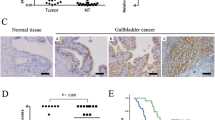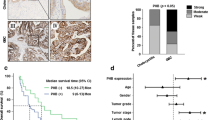Abstract
The mechanisms involved in gallbladder cancer metastasis still remain unclear to date. The poor understanding is due, in part, to the lack of ideal cell line and animal model for study. In the present study, 21 cell clones were isolated from the human gallbladder carcinoma cells GBC-SD and the cell clone GBC-SDHi with high invasive phenotype was fished out. The invasive phenotype and metastatic potential of GBC-SDHi were confirmed in a novel surgical orthotopic implantation model of gallbladder cancer in nude mice. Heparanase, an endoglycosidase that degrades heparan sulfate, is a critical mediator of tumor metastasis and angiogenesis. RT-PCR, real time RT-PCR and western blot showed that the expression levels of heparanase were significant difference between GBC-SDHi and its parent cells. After treated with antisense oligodeoxynucleotides, the heparanase mRNA and protein expression in GBC-SDHi cells were significantly decreased and its invasive potential in vitro was inhibited in a dose-dependent manner. The study provides a useful cell clone and a clinically relevant orthotopic tumor model for the metastatic study in human gallbladder cancer. The roles of heparanase in gallbladder cancer are also evaluated.





Similar content being viewed by others
Abbreviations
- SOI:
-
Surgical orthotopic implantation
- HPSE:
-
Heparanase
- HSPGs:
-
Heparan sulfate proteoglycans
- EPM:
-
Electrophoretic mobility
- ASODNs:
-
Antisense oligodeoxynucleotides
- NSODNs:
-
Nonsense oligodeoxynucleotides
References
Ito H, Matros E, Brooks DC, Osteen RT, Zinner MJ, Swanson RS, Ashley SW, Whang EE (2004) Treatment outcomes associated with surgery for gallbladder cancer: a 20-year experience. J Gastrointest Surg 8:183–190
Filder IJ (1978) Tumor heterogeneity and the biology of cancer invasion and metastasis. Cancer Res 38:2651–2660
Farabegoli F, Santini D, Ceccarelli C, Taffurelli M, Marrano D, Baldini N (2001) Clone heterogeneity in diploid and aneuploid breast carcinomas as detected by FISH. Cytometry 46:50–56
Bonsing BA, Corver WE, Fleuren GJ, Cleton-Jansen AM, Devilee P, Cornelisse CJ (2000) Allelotype analysis of flow-sorted breast cancer cells demonstrates genetically related diploid and aneuploid subpopulations in primary tumors and lymph node metastases. Genes Chromosomes Cancer 28:173–183
Fidler IJ (1990) Critical factors in the biology of human cancer metastasis: Twenty eighth G.H.A. Clowes Memorial Award Lecture. Cancer Res 50:6130–6138
Shindo-Okada N, Takeuchi K, Nagamachi Y (2001) Establishment of cell lines with high- and low-metastatic potential from PC-14 human lung adenocarcinoma. Jpn J Cancer Res 92:174–183
Navone NM, Olive M, Ozen M, Davis R, Troncoso P, Tu SM, Johnston D, Pollack A, Pathak S, von Eschenbach AC, Logothetis CJ (1997) Establishment of two human prostate cancer cell lines derived from a single bone metastasis. Clin Cancer Res 3:2493–2500
Li Y, Tian B, Yang J, Zhao L, Wu X, Ye SL, Liu YK, Tang ZY (2004) Stepwise metastatic human hepatocellular carcinoma cell model system with multiple metastatic potentials established through consecutive in vivo selection and studies on metastatic characteristics. J Cancer Res Clin Oncol 130:460–468
Flatmark K, GunhildMælandsmo GM, Martinsen M, Rasmussen H, Fodstad ∅ (2004) Twelve colorectal cancer cell lines exhibit highly variable growth and metastatic capacities in an orthotopic model in nude mice. Eur J Cancer 40:1593–1598
Fan YZ, Fu JY, Zhao ZM, Chen CQ (2005) Effect of norcantharidin on proliferation and invasion of human gallbladder carcinoma GBC-SD cells. World J Gastroenterol. 11(16):2431–2437
Finkel E (1999) Potential target found for antimetastasis drugs. Science 2:33
Naomoto Y, Takaoka M, Okawa T, Nobuhisa T, Gunduz M, Tanaka N (2005) The role of heparanase in gastrointestinal cancer. Oncol Rep 14:3–8
Xiao Y, Kleeff J, Shi X, Buchler MW, Friess H (2003) Heparanase expression in hepatocellular carcinoma and the cirrhotic liver. Hepatol Res 26:192–198
Dexter DL, Kowalski HM, Blazar BA, Fligiel Z, Vogel R, Heppner GH (1978) Heterogeneity of tumor cells from a single mouse mammary tumor. Cancer Res 38:3174–3181
Omasu F, Nakano Y, Ichiki T (2005) Measurement of the electrophoretic mobility of sheep erythrocytes using microcapillary chips. Electrophoresis 26:1163–1167
Albini A, Iwamoto Y, Kleinman HK, Martin GR, Aaronson SA, Kozlowski JM, McEwan RN (1987) A rapid in vitro assay for quantitating the invasive potential of tumor cells. Cancer Res 47:3239–3245
Zheng JP, Rudra GN, Powell WC et al (1999) Suppression of prostate carcinoma cell invasion by expression of antisense L-plastin. Gene Am J Pathol 155:115–122
Seabright M (1971) A rapid banding technique for human chromosomes. Lancet 2:971–972
Zhang YL, Fu ZR, Zhang J et al (2003) Inhibition of invasiveness of human mammary carcinoma cell line MDA435 by heparanase antisense oligodeoxynucleotide. Zhonghua Yi Xue Za Zhi 83:204–207
Chen AB, Ding YQ, Xie XM, Liu Z, Zhang H (2002) Constructing a high metastasis subline from Lovo cell and studying its biological characteristics. Cancer Res Clin 14:85–88
Nakano T, Tani M, Ishibashi Y, Kimura K, Park YB, Imaizumi N, Tsuda H, Aoyagi K, Sasaki H, Ohwada S, Yokota J (2003) Biological properties and gene expression associated with metastatic potential of human osteosarcoma. Clin Exp Metastasis 20:665–674
Nowell PC (1976) The clonal evolution of tumor cell population. Science 194:23–28
Chang XZ, Wang ZM, Li ZW et al (2004) Establishment of human gallbladder cancer surgical orthotopic implantation model in nude mice. Chin J Hepatobiliary surg 10(7):468–472
Li Y, Tang ZY, Ye SL, Liu YK, Chen J, Xue Q, Chen J, Gao DM, Bao WH (2001) Establishment of cell clones with different metastatic potential from the metastatic hepatocellular carcinoma cell line MHCC97. World J Gastroenterol 7:630–636
Takeuchi S, Nakanishi H, Yoshida K, Yamamoto S, Tonoki H, Tsukamoto T, Fukushima S, Moriuchi T, Kurita K, Tatematsu M (2000) Isolation of differentiated squamous and undifferentiated spindle carcinoma cell lines with differing metastatic potential from a 4-nitroquinoline N-Oxide-induced tongue carcinoma in a F344 rat. Jpn J Cancer Res 91:1211–1221
Yang YJ, Zhang YL, Li X et al (2003) Contribution of eIF-4E inhibition to the expression and activity of heparanase in human colon adenocarcinoma cell line: LS-174T. World J Gastroenterol 9:1707–1712
Yasoshima T, Denno R, Kawaguchi S, Sato N, Okada Y, Ura H, Kikuchi K, Hirata K (1996) Establishment of human gastric carcinoma lines with high metastatic potential in the liver: changes in integrin expression associated with the ability to metastasize in the liver of nude mice. Jpn J Cancer Res 87:153–160
Samiei M, Waghorne CG (1991) Clonal selection within metastatic SPI mouse mammary tumors is independent of metastatic potential. Int J Cancer 47:771–775
Price JE, Bell C, Frost P (1990) The use of a genotypic marker to demonstrate clonal dominance during the growth and metastasis of a human breast carcinoma in nude mice. In J Cancer 45:968–971
Hoffman RM (2005) Orthotopic metastatic (MetaMouse) models for discovery and development of novel chemotherapy. Methods Mol Med 111:297–322
Katz MH, Takimoto S, Spivack D, Moossa AR, Hoffman RM, Bouvet M (2004) An imageable highly metastatic orthotopic red fluorescent protein model of pancreatic cancer. Clin Exp Metastasis 21:7–12
Illert B, Otto C, Braendlein S, Thiede A, Timmermann W (2003) Optimization of a metastasizing human gastric cancer model in nude mice. Microsurgery 23:508–512
Rashidi B, Gamagami R, Sasson A, Sun FX, Geller J, Moossa AR, Hoffman RM (2000) An orthotopic mouse model of remetastasis of human colon cancer liver metastasis. Clin Cancer Res 6:2556–2561
Horiuchi H, Kawamata H, Fujimori T, Kuroda Y (2003) A MEK inhibitor (U0126) prolongs survival in nude mice bearing human gallbladder cancer cells with K-ras mutation: analysis in a novel orthotopic inoculation model. Int J Oncol 23:957–963
An Z, Jiang P, Wang X, Moossa AR, Hoffman RM (1999) Development of a high metastatic orthotopic model of human renal cell carcinoma in nude mice: benefits of fragment implantation compared to cell-suspension injection. Clin Exp Metastasis 17:265–270
Chen JQ, Zhan WH, He YL et al (2004) Expression of heparanase gene, CD44v6, MMP-7 and nm23 protein and their relationship with the invasion and metastasis of gastric carcinomas. World J Gastroenterol 10:776–782
Sinnappah-Kang ND, Kaiser AJ, Blust BE, Mrak RE, Marchetti D (2005) Heparanase, TrkC and p75NTR: their functional involvement in human medulloblastoma cell invasion. Int J Oncol 27:617–626
Vlodavsky I, Friedmann Y, Elkin M et al (1999) Mammalian heparanase: gene cloning, expression and function in tumor progression and metastasis. Nat Med 5:793–802
Hulett MD, Freeman C, Hamdorf BJ et al (1999) Cloning of mammalian heparanase, an important enzyme in tumor invasion and metastasis. Nat Med 5:803–809
Parish CR, Freeman C, Hulett MD (2001) Heparanase: a key enzyme involved in cell invasion. Biochim Biophys Acta 1471:99–108
Kuniyasu H, Chihara Y, Kubozoe T, Takahashi T (2002) Co-expression of CD44v3 and heparanase is correlated with metastasis of human colon cancer. Int J Mol Med 10:333–337
Kim AW, Xu X, Hollinger EF et al (2002) Human heparanase-1 gene expression in pancreatic adenocarcinoma. J Gastrointest Surg 6:167–172
Rohloff J, Zinke J, Schoppmeyer K et al (2002) Heparanase expression is a prognostic indicator for postoperative survival in pancreatic adenocarcinoma. Br J Cancer 86:1270–1275
Uno F, Fujiwara T, Takata Y et al (2001) Antisense-mediated suppression of human heparanase gene expression inhibits pleural dissemination of human cancer cells. Cancer Res 61:7855–7860
Chen KS, Zhang L, Tang L, Zhang YH, Gao DL, Yan L, Zhang L (2005) Expression of heparanase mRNA in anti-sense oligonucleotide-transfected human esophageal cancer EC9706 cells. World J Gastroenterol 11:4916–4919
Miao HQ, Elkin M, Aingorn E et al (1999) Inhibition of heparanase activity and tumor metastasis by laminarin sulfate and synthetic phosphorothioate oligodeoxynucleotides. Int J Cancer 83:424–431
Parish CR, Freeman C, Brown KJ et al (1999) Identification of sulfated oligosaccharide-based inhibitors of tumor growth and metastasis using novel in vitro assays for angiogenesis and heparanase activity. Cancer Res 59:3433–3441
Acknowledgements
We gratefully acknowledge Xiao-Peng Wu, Zhi-Lun Zhao, Dao-Xin Ma, Bo Liu, Lei Wang and Lu-Bin Tang for their excellent technical assistance in cell culture, cell electrophoresis, western blot, in vitro invasion and migration assays, respectively. This research was supported in part by the Grant from Shandong Science and Technology Committee (No. 003130107 and No. 963000053).
Author information
Authors and Affiliations
Corresponding author
Additional information
This work was supported in part by the Grant from Shandong Science and Technology Committee (No. 003130107 and No. 963000053)
Rights and permissions
About this article
Cite this article
Chang, XZ., Wang, ZM., Yu, JM. et al. Isolation of a human gallbladder cancer cell clone with high invasive phenotype in vitro and metastatic potential in orthotopic model and inhibition of its invasiveness by heparanase antisense oligodeoxynucleotides. Clin Exp Metastasis 24, 25–38 (2007). https://doi.org/10.1007/s10585-006-9053-7
Received:
Accepted:
Published:
Issue Date:
DOI: https://doi.org/10.1007/s10585-006-9053-7




